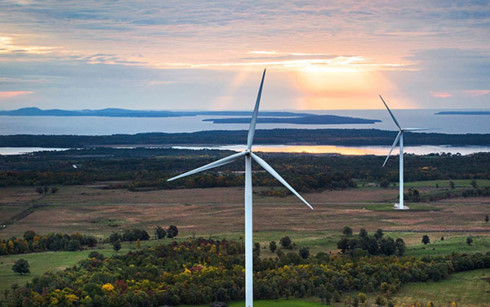Although wind power development is considered a great potential sector in Vietnam, investors have been hesitant to develop new or expand their existing projects due to the low regulated selling price of wind power lengthening the time to recover investment capital by a significant margin.
Forever to recover investment capital

In November 2016, Thuan Binh Wind Power JSC started the operation of the first phase of Phu Lac wind far,, with a capacity of 2MW. To date, the plant contributes 56 million kWh to the national grid.
However, the investor has raised concerns about the time to recover the investment capital.
According to Bui Van Thinh, chairman of Thuan Binh Wind Power JSC, the regulated selling price of wind power in Vietnam is among the lowest in the world, only 7.8 cent per kWh (compared to the 20 cent per kWh in Thailand, the 29 cent per kWh in the Philippines, and 30 cent per kWh in Japan).
The first phase of the project has a total investment capital sum of VND1.1 trillion (US$48.4 million). With the existing selling price, it will take the company 14 years to recover their investment.
According to the plan, after operating the first phase of Phu Lac wind farm, the company planned to develop four other similar plants, including two in the south central provinces of Ninh Thuan and Binh Thuan and two in the Central Highlands provinces of Dak Lak and Gia Lai.
However, these plans might just become dust in the wind if the selling price does not increase.
Thinh stated that with the existing selling price, it is difficult for Vietnam to reach the target of generating 800MW of wind power by 2020.
Regarding the relationship between the localisation rate of equipment production and the potential of the sector’s development, Thinh said that at present, equipment manufactured domestically is rarely used, accounting for 20% of the total expenditure on turbines, while the remaining parts have been imported.
In the future, enterprises in Vietnam will manufacture more equipment, increasing the localisation rate to 40-50% of the total expenditure on turbines.
This will increase the appeal of the Vietnamese wind power sector because domestic equipment is generally cheaper than imported equipment.
“At present, investors’ highest concern is the output of their products. Most projects have been postponed because regulated prices were below production costs. They are waiting for the government’s decision to increase the feed-in tariff (FiT) to restart construction,” Thinh added.
Notably, Ben Tre province licensed five wind power projects with a total capacity of 150MW, but investors have been waiting for the FiT to increase. 19 more wind power projects were registered in Binh Thuan, but work on them has yet to begin.
Opportunities for solar power
Thuan Binh plans to develop a 150MW solar power plant on the area which the company initially planned to use to expand Phu Lac wind power project. The construction of the solar power project will be implemented in three phases.
The company is conducting the pre-feasibility study, an environmental impact assessment, and capital arrangement for the first phase of the project.
Thinh said that investing in solar power have more benefits than wind power because the regulated selling price is 9.35 cent per kWh.
Besides, in the country’s new power development plan, Vietnam expects to generate 85 MW of solar power by 2020, 4,000MW by 2025, and 12,000MW by 2030.
VIR